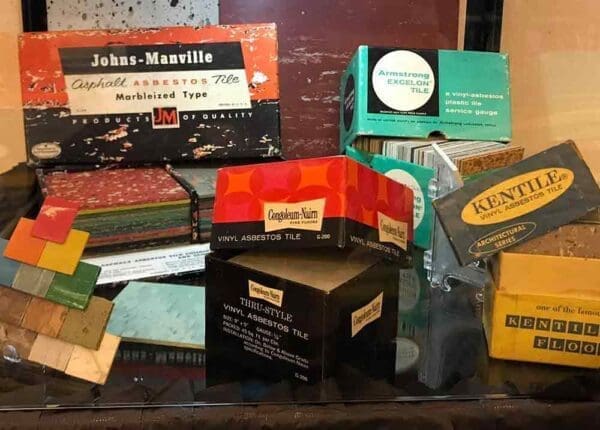01. Asbestos Use in Vinyl Products
Why Was Asbestos Used in Vinyl Products?
Vinyl is a synthetic, resin material. It is cheap, durable, easy to clean and customizable. Manufacturers added asbestos to vinyl products to enhance their durability and heat resistance.
Because of its properties, vinyl has been an ideal material for resilient flooring and wall coverings for decades. Vinyl flooring products are especially popular as inexpensive substitutes for linoleum flooring.
Prior to the 1980s, asbestos was added to vinyl products. For instance, asbestos was commonly used in the following vinyl materials:
- The backing of vinyl wallpaper for fireproofing
- Vinyl asbestos floor tiles to add strength, durability and heat resistance
- The backing of vinyl sheet flooring
- The asbestos-containing adhesive used to install vinyl wallpaper and flooring
By the 1980s, manufacturers stopped the use of asbestos in vinyl products. Around this time, the Environmental Protection Agency (EPA) and other agencies implemented stricter asbestos regulations. Thus, it’s more common to find asbestos vinyl products in older homes and buildings.
Asbestos Vinyl Products History at a Glance
- Other Names: Vinyl asbestos floor tiles, vinyl sheet flooring, vinyl wallpaper
- Years of Manufacture: 1907 – 1986
- Places Used: Wall coverings, flooring
- Asbestos Use Banned: No
- Noteworthy Brands: Armstrong World Industries, The Flintkote Company, GAF Corporation, Kentile Floors
02. List of Asbestos Vinyl Products
Complete List of Asbestos Vinyl Products
Asbestos vinyl products have been used in homes, schools and commercial buildings for decades prior to regulations. These products could contain high quantities of asbestos. According to one study, researchers found vinyl asbestos flooring may contain anywhere between 10 to 25% asbestos.
As these products age, they may cause dangerous asbestos exposure to individuals in the surrounding areas. Exposure may cause various asbestos-related diseases, including mesothelioma, asbestosis and lung cancer.
| Product Name | Start Year | End Year |
|---|---|---|
| Armstrong Excelon Vinyl Asbestos Floor Tile | ||
| Armstrong Vinyl Asbestos Tile | ||
| Flintkote Vinyl Asbestos Floor Tile | ||
| GAF Bright Future Luxor Vinyl Floors | ||
| GAF Fashioncraft VinylFlex Floor Tile | ||
| GAF Luran Airtred Vinyl Floors | ||
| GAF Sheet Vinyl A-1 Vinyl Floors | ||
| GAF Stoneglow Vinyl-Asbestos Floor Tile | ||
| GAF Sure-Stik Adhesive-Backed Vinyl Asbestos Tile | ||
| GAF Vinyl Asbestos Floor Tile | ||
| GAF VinylFlex Floor Tile | ||
| Kentile Floors Vinyl Sheet Flooring | 1907 | 1986 |
| Kentile Floors KenFlex Vinyl Asbestos Tile | 1907 | 1986 |
| National Gypsum Vinyl Topping Compound | ||
| National Gypsum Gold Bond Vinyl Topping Compound | ||
| Synkoloid Vinyl Concrete & Masonry Patch | ||
| Synkoloid Vinyl Prep Mix | 1962 | 1975 |
| Synkoloid Vinyl Tex Wall Surface Conditioner Paste | 1972 | 1976 |
Several companies manufactured asbestos-containing vinyl floor tiles and other vinyl products containing asbestos. Because vinyl products were popular for some time, thousands of workers and homeowners may have been exposed to these companies’ products.
03. Vinyl Products & Asbestos Exposure
Who Is at Risk of Asbestos Exposure From Vinyl Products?
Workers who manufactured asbestos-containing vinyl products and individuals who installed vinyl asbestos tiles face the greatest risk of exposure. Workers often sanded or cut the tiles during the installation process. This could release dangerous asbestos fibers into the air.
Vinyl materials are no longer produced with asbestos in the United States. However, there is still a risk of exposure. Contractors and workers in the construction industry removing vinyl asbestos materials continue to risk asbestos exposure.
Contractors and construction crews removing vinyl wallpaper or flooring in old homes and buildings may be exposed to the asbestos fibers.
Maintenance workers who clean vinyl asbestos flooring may also be at risk. Using abrasive cleaners or machinery on the flooring may cause damage that releases fibers.
Additionally, individuals who live or work around these products in older buildings may be at risk of exposure. For example, homeowners may find vinyl asbestos products in homes built before 1980. As these products deteriorate with age, they can expose homeowners to harmful asbestos fibers. Renovations or home projects can also potentially damage the vinyl products, releasing fibers into the air.
04. Asbestos Lawsuits
Asbestos Lawsuits, Settlements & Other Compensation
Individuals who developed an asbestos-related disease as a result of working with asbestos-containing vinyl products may be eligible for financial compensation. For instance, workers with a history of installing vinyl asbestos tiles have filed mesothelioma claims with flooring manufacturers.
Manufacturers have paid millions of dollars in financial compensation to asbestos victims. Individuals may pursue different types of compensation claims, including an asbestos lawsuit or trust fund claim.
Several asbestos tile manufacturers have established asbestos trust funds to compensate current and future asbestos victims. For example, individuals who used asbestos construction products developed by Congoleum may be eligible to submit a claim to the company’s trust fund.
Mesothelioma lawyers can help victims and their loved ones navigate the best legal options. Many asbestos victims exposed by way of vinyl products have secured compensation.
Goodyear Sued Over Vinyl Asbestos Floor Tiles
In September 2017, Peter Komiak was diagnosed with mesothelioma. Komiak was a carpenter who worked for several companies specializing in home renovations.
Throughout the course of his career, Komiak installed Goodyear vinyl asbestos tiles in multiple commercial and residential buildings. To install the tiles, Komiak had to score and cut the material. This often released airborne dust containing asbestos fibers.
In October 2017, Komiak filed an asbestos lawsuit against Goodyear. In 2018, Komiak died from cancer.
Goodyear attempted to have the case dismissed, but the company’s motion was denied. No trial date has been set yet. Any award secured in Komiak’s name will likely benefit his surviving loved ones.
05. Asbestos Vinyl Product Removal
Safely Removing Asbestos Vinyl Products
Removing vinyl products that contain asbestos from a home or building should only be done by a licensed, knowledgeable professional. Asbestos abatement professionals know how to properly remove and dispose of asbestos products without exposure.
Professionals should be called immediately if vinyl asbestos tiles are damaged or worn down. In good condition, vinyl asbestos tiles are non-friable and less likely to cause exposure. However, when broken, chipped or crumbling, they can release asbestos fibers into the air.
Vinyl sheet flooring with friable asbestos backing poses an even greater risk of exposure during asbestos removal.
However, homeowners do have another option when it comes to renovating rooms with asbestos vinyl flooring. If the flooring is in good condition, modern tile or sheet flooring can be installed directly over the top of the original tiles or flooring.
This process seals in the asbestos, protecting homeowners from exposure while updating the look of the space. Before any renovation or home projects, homeowners should still consider having an asbestos inspection. A qualified inspector can determine the presence of asbestos and any next steps needed.





